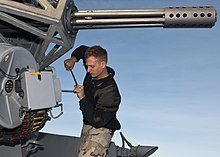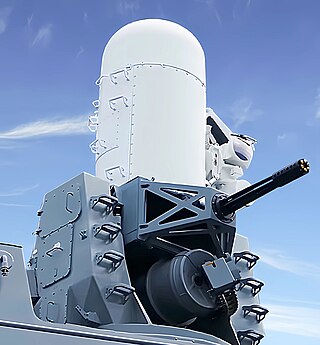
The Phalanx CIWS is an automated gun-based close-in weapon system to defend military watercraft automatically against incoming threats such as aircraft, missiles, and small boats. It was designed and manufactured by the General Dynamics Corporation, Pomona Division, later a part of Raytheon. Consisting of a radar-guided 20 mm (0.8 in) Vulcan cannon mounted on a swiveling base, the Phalanx has been used by the United States Navy and the naval forces of 15 other countries. The US Navy deploys it on every class of surface combat ship, except the Zumwalt-class destroyer and San Antonio-class amphibious transport dock. Other users include the British Royal Navy, the Royal Australian Navy, the Royal New Zealand Navy, the Royal Canadian Navy, and the U.S. Coast Guard.

An anti-ship missile (AShM) is a guided missile that is designed for use against ships and large boats. Most anti-ship missiles are of the sea skimming variety, and many use a combination of inertial guidance and active radar homing. A large number of other anti-ship missiles use infrared homing to follow the heat that is emitted by a ship; it is also possible for anti-ship missiles to be guided by radio command all the way.
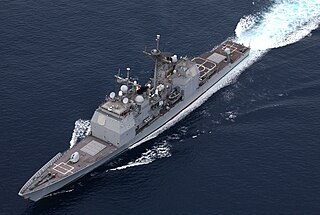
The Aegis Combat System is an American integrated naval weapons system, which uses computers and radars to track and guide weapons to destroy enemy targets. It was developed by the Missile and Surface Radar Division of RCA, and it is now produced by Lockheed Martin.
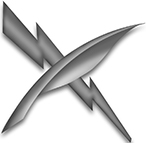
Cryptologic technician (CT) is a United States Navy enlisted rating or job specialty. The CT community performs a wide range of tasks in support of the national intelligence-gathering effort, with an emphasis on cryptology and signal intelligence related products.

The Tartar Guided Missile Fire Control System is an air defense system developed by the United States Navy to defend warships from air attack. Since its introduction the system has been improved and sold to several United States allies.
The Navy Enlisted Classification (NEC) system supplements the rating designators for enlisted members of the United States Navy. A naval rating and NEC designator are similar to the Military Occupational Specialty (MOS) designators used in the U.S. Army and U.S. Marine Corps and the Air Force Specialty Code (AFSC) used in the U.S. Air Force and the U.S. Space Force.
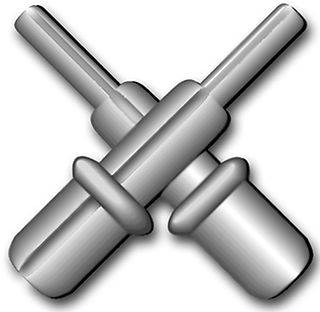
The United States Navy and United States Coast Guard occupational rating of gunner's mate (GM) is a designation given by the Bureau of Naval Personnel (BUPERS) to enlisted sailors who either satisfactorily complete initial Gunner's Mate "A" school training, or who "strike" for the rating by showing competence in the field of ordnance. When "striking" one isn't required to be a seaman, but must belong to one of three undesignated rates: Fireman (FN), Seaman (SN), or Airman (AN). It is also possible to cross rate to Gunner's Mate. Cross rating refers to the act of an enlisted sailor "crossing" from their current rating to another rating of their choice, provided their ASVAB scores are high enough and there are open slots for the rate.

Aviation electronics technician (AT) is a US Navy enlisted rating or job specialty. At the paygrade of E-9, ATs merge with the aviation electrician's mate (AE) rating to become avionics technicians (AV). There has been talk of completely merging the two ratings, but as yet no definite plans have been announced. Aviation electronics technicians wear the specialty mark of a winged helium atom.

People who are in the damage controlman (DC) rating are the Navy's and Coast Guard’s maintenance and emergency repair specialists.
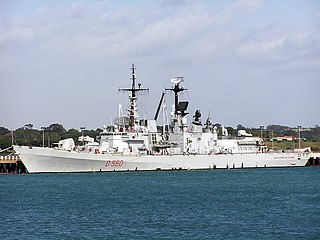
The Durand de la Penne class are two guided-missile destroyers operated by the Italian Navy. The design is an enlarged version of the Audace class, updated with diesel and gas turbine CODOG machinery and modern sensors. Four ships were planned but the second pair were cancelled when Italy joined the Horizon project.
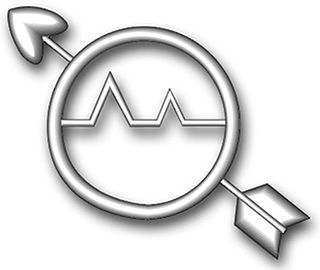
Operations Specialist is a United States Navy and United States Coast Guard occupational rating. It is a sea duty-intensive rating in the Navy while most of Coast Guard OS's are at ashore Command Centers.

The Iowa-class battleships are the most heavily armed warships the United States Navy has ever put to sea, due to the continual development of their onboard weaponry. The first Iowa-class ship was laid down in June 1940; in their World War II configuration, each of the Iowa-class battleships had a main battery of 16-inch (406 mm) guns that could hit targets nearly 20 statute miles (32 km) away with a variety of artillery shells designed for anti-ship or bombardment work. The secondary battery of 5-inch (127 mm) guns could hit targets nearly 9 statute miles (14 km) away with solid projectiles or proximity fuzed shells, and was effective in an anti-aircraft role as well. Each of the four battleships carried a wide array of 20 mm and 40 mm anti-aircraft guns for defense against enemy aircraft.

The United States Navy occupational rating of data systems technician was a designation given by the Bureau of Naval Personnel (BUPERS) to enlisted members who satisfactorily complete initial data systems technician "A" school training. The primary training location for the DS rating was Combat System Technical Schools Command (CSTSC) at Mare Island Vallejo, CA.

Ship gun fire-control systems (GFCS) are analogue fire-control systems that were used aboard naval warships prior to modern electronic computerized systems, to control targeting of guns against surface ships, aircraft, and shore targets, with either optical or radar sighting. Most US ships that are destroyers or larger employed gun fire-control systems for 5-inch (127 mm) and larger guns, up to battleships, such as Iowa class.

Information systems technician (IT) is a rating for United States Navy and United States Coast Guard enlisted personnel, specializing in communications technology. Information systems technician submarines (ITS) is a rating for U.S. Navy submariners. The Information systems technician (IT) rating corresponds to the new Navy Occupational Specialty (NOS) code B460 while the information systems technician submarines (ITS) rating corresponds to Navy Occupational Specialty (NOS) code C260.

The United States Navy job rating of electronics technician (ET) is a designation given by the Bureau of Naval Personnel (BUPERS) to enlisted members who satisfactorily complete initial Electronics Technician "A" school training.

The Mark 34 Gun Weapon System (GWS) is a component of the Aegis Combat System that is responsible for controlling and providing fire control to the 5" Mark 45 gun. It is used on the U.S. Navy Arleigh Burke-class destroyer and several later Ticonderoga-class cruisers. The Mk 34 GWS receives target data from the ship's sensors and off-ship sources, performs ballistic calculations, and produces gun control orders. The system is made up of the gun mount itself, the fire-control computer, and an optical sight.

The Center for Surface Combat Systems (CSCS) is one of eleven learning centers of Naval Education and Training Command, headquartered on Naval Support Facility Dahlgren operated learning centers for the education and training of United States Navy personnel on the operation and use of shipboard combat systems, including the Aegis Combat System, SSDS, tactical data links and other systems that can be used in the ship's combat information center (CIC). Through 70,000 hours' worth of curriculum in 700 courses, CSCS provides the fleet with highly trained surface warfare officers and enlisted personnel in the ratings of fire controlmen, electronic technicians, interior communications electricians, sonar technicians (surface), gunner's mates, minemen, operations specialists, and boatswain's mates.

The AN/SPG-62 is a continuous wave fire-control radar developed by the United States, and it is currently deployed on warships equipped with the Aegis Combat System. It provides terminal target illumination for the semi-active SM-2MR/ER and ESSM Block 1 surface-to-air missiles. It also provides illumination for the active SM-6 if it is used in semi-active mode. The antenna is mechanically steered, uses a parabolic reflector, and operates at 8 to 12 GHz. The system is a component of the Mk 99 fire-control system (FCS).

